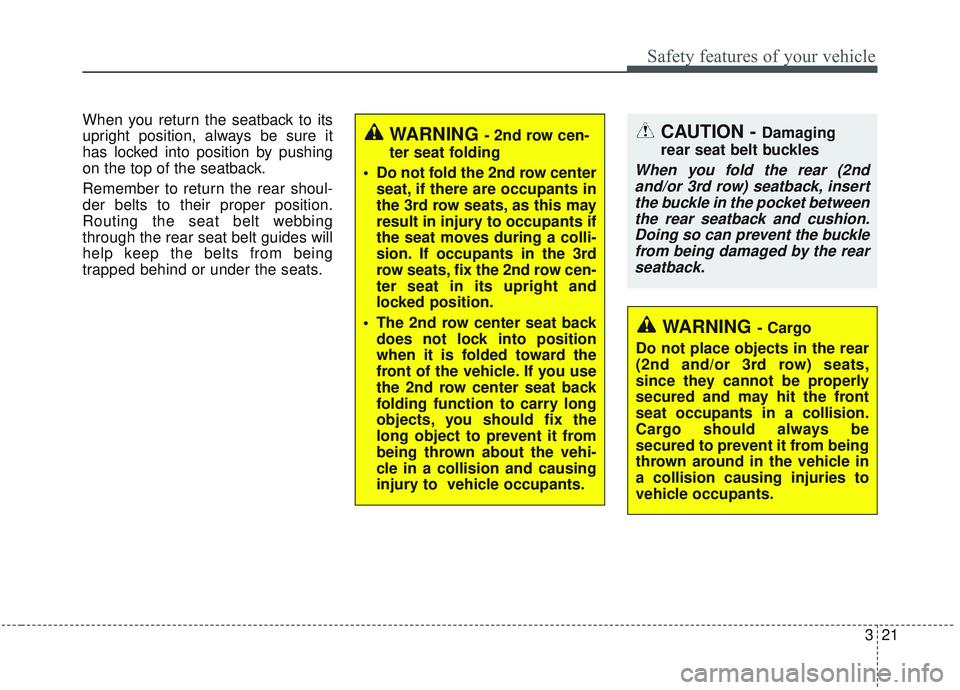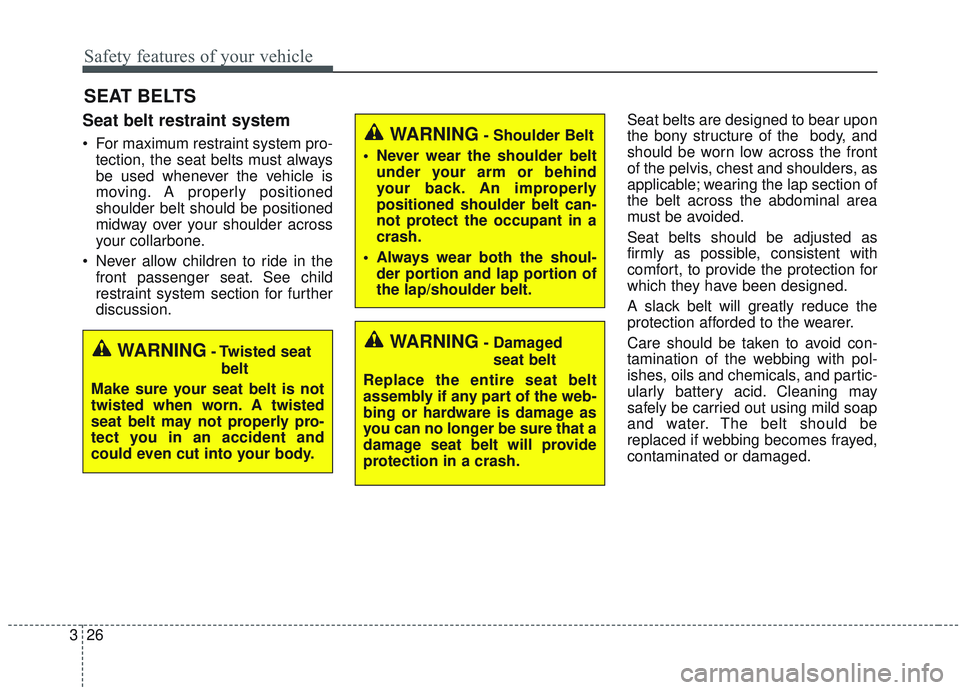Page 31 of 573
Safety features of your vehicle
14
3
2. Raise headrest as far as it can go.
3. Press the headrest release button
(3) or press the release button with
slim tool (3) (for Type C and Type D)
while pulling the headrest up.
To reinstall the headrest :
1. Put the headrest poles (2) into theholes while pressing the release
button (1) or pressing the release
button with slim tool (1,for Type C
and D).
WARNING
NEVER allow anyone to ride in a
seat with the headrest removed.
OUM038014
OUM038015
■
Type B
■Type A
OUMA038012
OUMA038201
■
Type D
■Type C
Page 32 of 573
315
Safety features of your vehicle
2. Recline the seatback (4) with therecline lever or switch (3).
3. Adjust the headrest to the appro- priate height.Seatback pocket (if equipped)
The seatback pocket is provided on
the back of the front passenger’s and
driver’s seatbacks.
WARNING- Headrest
Reinstallation
To reduce the risk of injury to
the head or neck, always make
sure the headrest is locked into
position and adjusted properly
after reinstalling.
OUMA038116
WARNING- Seatback pockets
Do not put heavy or sharp
objects in the seatback pockets.
In an accident they could come
loose from the pocket and
injure vehicle occupants.
OUMA038015
OUMA038202
■
Type D
■Type C
Page 34 of 573

317
Safety features of your vehicle
3. Fold the 2nd row seatback andpush the seat to the farthest for-
ward position.
After getting in or out, slide the 2nd
row seat to the farthest rearward
position and pull the seatback firmly
backward until it clicks into place.
Make sure that the seat is locked in
place.
Folding the rear seat
The rear seatbacks can be folded to
facilitate carrying long items or to
increase the luggage capacity of the
vehicle.
WARNING - Objects
Objects carried on the folded
down seatback should not
extend higher than the top of
the front seatbacks. This could
allow cargo to slide forward and
cause injury or damage during
sudden stops.
WARNING
Never allow passengers to sit on
top of the folded down seatback
while the vehicle is moving. This
is not a proper seating position
and no seat belts are available
for use. This could result in seri-
ous injury or death in case of an
accident or sudden stop.
WARNING
Never attempt to adjust the 2nd
row seat while the vehicle is
moving or the seat is occupied
as the seat may suddenly move
and cause the passenger on the
seat to be injured.
OUM034024L
Page 37 of 573
Safety features of your vehicle
20
3
2nd row seat folding
(from outside, if equipped)
Pull the 2nd row seat back folding
lever out.
The 2nd row seat back will be folded.
If you pull the left side lever (1) out,
left side seat back and center seat
back will be folded.
If you pull the right side lever (2) out,
right side seat back will be folded.
To fold down the rear center seat-back (for 2nd row seat)
1. Lower the rear headrests to the lowest position.
2. Push the center seatback folding lever up, then fold the seat toward
the front of the vehicle.
WARNING - Rear seat
folding
Do not fold the rear seats (2nd &
3rd row seats), if passengers,
pets or luggage are in the rear
seats.
It may cause injury or damage
to passengers, pets or luggage.
OUMA034030OUM034031L
Page 38 of 573

321
Safety features of your vehicle
When you return the seatback to its
upright position, always be sure it
has locked into position by pushing
on the top of the seatback.
Remember to return the rear shoul-
der belts to their proper position.
Routing the seat belt webbing
through the rear seat belt guides will
help keep the belts from being
trapped behind or under the seats.
WARNING - 2nd row cen-
ter seat folding
Do not fold the 2nd row center seat, if there are occupants in
the 3rd row seats, as this may
result in injury to occupants if
the seat moves during a colli-
sion. If occupants in the 3rd
row seats, fix the 2nd row cen-
ter seat in its upright and
locked position.
The 2nd row center seat back does not lock into position
when it is folded toward the
front of the vehicle. If you use
the 2nd row center seat back
folding function to carry long
objects, you should fix the
long object to prevent it from
being thrown about the vehi-
cle in a collision and causing
injury to vehicle occupants.CAUTION - Damaging
rear seat belt buckles
When you fold the rear (2nd and/or 3rd row) seatback, insertthe buckle in the pocket betweenthe rear seatback and cushion.Doing so can prevent the bucklefrom being damaged by the rearseatback.
WARNING- Cargo
Do not place objects in the rear
(2nd and/or 3rd row) seats,
since they cannot be properly
secured and may hit the front
seat occupants in a collision.
Cargo should always be
secured to prevent it from being
thrown around in the vehicle in
a collision causing injuries to
vehicle occupants.
Page 39 of 573
Safety features of your vehicle
22
3
Armrest (2nd row seat)
To use the armrest, pull it forward
from the seatback.
Headrest (for rear seat)
The rear seat(s) is equipped with
headrests in all the seating positions
for the occupant's safety and comfort.
The headrests not only provide com-
fort for passengers, but also helps
protect the head and neck in the
event of a collision.
For maximum effectiveness in case of
an accident, the headrest should be
adjusted so the middle of the head-
rest is at the same height as the cen-
ter of gravity of an occupant's head.
OUN026140
WARNING - 3rd row seat
3rd row occupants should always
remain in the center of the seat
cushion so the occupants head
is protected by the headrest.
If not, the tailgate may hit the
occupant's head, which could
cause injury.
OUM034021LOHM038049N
* : if equipped
*
*
Page 41 of 573
Safety features of your vehicle
24
3
Removal and reinstallation
(for 2nd row seats)To remove the headrest :
1. Raise it as far as it can go then press the release button (1) while
pulling the headrest up (2).
To reinstall the headrest :
1. Put the headrest poles (3) into the holes while pressing the release
button (1).
2. Adjust it to the appropriate height.
OUM034087L
OUMA034093
■
Outside
■ Center
WARNING
Make sure the headrest locks
in position after adjusting it to
properly protect the occu-
pants.
After installing the headrest, make sure that it is installed
in the right direction.
A headrest installed reversely
could increase whiplash injury
during rear impact.
Page 43 of 573

Safety features of your vehicle
26
3
SEAT BELTS
Seat belt restraint system
For maximum restraint system pro-
tection, the seat belts must always
be used whenever the vehicle is
moving. A properly positioned
shoulder belt should be positioned
midway over your shoulder across
your collarbone.
Never allow children to ride in the front passenger seat. See child
restraint system section for further
discussion. Seat belts are designed to bear upon
the bony structure of the body, and
should be worn low across the front
of the pelvis, chest and shoulders, as
applicable; wearing the lap section of
the belt across the abdominal area
must be avoided.
Seat belts should be adjusted as
firmly as possible, consistent with
comfort, to provide the protection for
which they have been designed.
A slack belt will greatly reduce the
protection afforded to the wearer.
Care should be taken to avoid con-
tamination of the webbing with pol-
ishes, oils and chemicals, and partic-
ularly battery acid. Cleaning may
safely be carried out using mild soap
and water. The belt should be
replaced if webbing becomes frayed,
contaminated or damaged.
WARNING- Damaged
seat belt
Replace the entire seat belt
assembly if any part of the web-
bing or hardware is damage as
you can no longer be sure that a
damage seat belt will provide
protection in a crash.WARNING- Twisted seat belt
Make sure your seat belt is not
twisted when worn. A twisted
seat belt may not properly pro-
tect you in an accident and
could even cut into your body.
WARNING- Shoulder Belt
Never wear the shoulder belt under your arm or behind
your back. An improperly
positioned shoulder belt can-
not protect the occupant in a
crash.
Always wear both the shoul- der portion and lap portion of
the lap/shoulder belt.